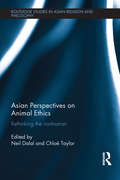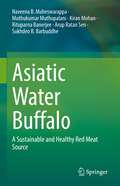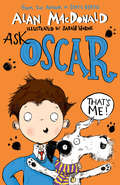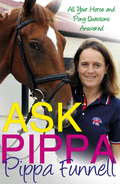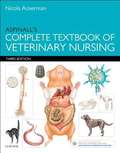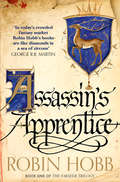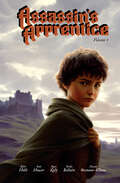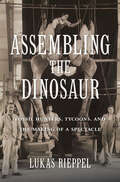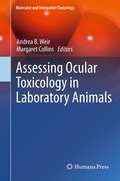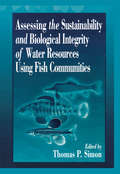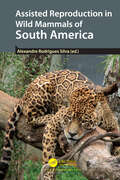- Table View
- List View
Asian Perspectives on Animal Ethics: Rethinking the Nonhuman
by Neil Dalal Chloë TaylorTo date, philosophical discussions of animal ethics and Critical Animal Studies have been dominated by Western perspectives and Western thinkers. This book makes a novel contribution to animal ethics in showing the range and richness of ideas offered to these fields by diverse Asian traditions. Asian Perspectives on Animal Ethics is the first of its kind to include the intersection of Asian and European traditions with respect to human and nonhuman relations. Presenting a series of studies focusing on specific Asian traditions, as well as studies that put those traditions in dialogue with Western thinkers, this book looks at Asian philosophical doctrines concerning compassion and nonviolence as these apply to nonhuman animals, as well as the moral rights and status of nonhuman animals in Asian traditions. Using Asian perspectives to explore ontological, ethical and political questions, contributors analyze humanism and post-humanism in Asian and comparative traditions and offer insight into the special ethical relations between humans and other particular species of animals. This book will be of interest to students and scholars of Asian religion and philosophy, as well as to those interested in animal ethics and Critical Animal Studies.
Asian Perspectives on Animal Ethics: Rethinking the Nonhuman
by Neil Dalal Chloë TaylorTo date, philosophical discussions of animal ethics and Critical Animal Studies have been dominated by Western perspectives and Western thinkers. This book makes a novel contribution to animal ethics in showing the range and richness of ideas offered to these fields by diverse Asian traditions. Asian Perspectives on Animal Ethics is the first of its kind to include the intersection of Asian and European traditions with respect to human and nonhuman relations. Presenting a series of studies focusing on specific Asian traditions, as well as studies that put those traditions in dialogue with Western thinkers, this book looks at Asian philosophical doctrines concerning compassion and nonviolence as these apply to nonhuman animals, as well as the moral rights and status of nonhuman animals in Asian traditions. Using Asian perspectives to explore ontological, ethical and political questions, contributors analyze humanism and post-humanism in Asian and comparative traditions and offer insight into the special ethical relations between humans and other particular species of animals. This book will be of interest to students and scholars of Asian religion and philosophy, as well as to those interested in animal ethics and Critical Animal Studies.
Asiatic Water Buffalo: A Sustainable and Healthy Red Meat Source
by Naveena B. Maheswarappa Muthukumar Muthupalani Kiran Mohan Rituparna Banerjee Arup Ratan Sen Sukhdeo B. BarbuddheThis need-based unique book deals exclusively with water buffalo (Bubalus bubalis) meat to provide much needed information to thousands of buffalo meat processors across the world. The information provided in this first-of-its-kind book on buffalo meat quality, nutritional characteristics, safety, and processing can be utilized by buffalo meat producers and meat processors for the advancement of the buffalo meat sector. It also provides valuable information to faculty members, students, researchers, and all other readers interested in this new source of meat. Owing to the limited research and scientific literature available on buffalo meat, the authors’ own research findings and our experiences were included wherever required to give crisp, practical, and complete information. The information proposed in this book should be beneficial to the entire buffalo industry, from the farming and processing of buffaloes to the marketing of products. This serve as a handy guide to meat scientists, faculty members, and students willing to learn more about buffalo meat processing. Up-to-date relevant references were also included for the benefit of researchers and students to enable them to easily access further information. Above all, it provides valuable information to consumers who are interested to know this new and potential source of meat.
Ask Oscar (Ask Oscar Ser. #1)
by Alan MacDonaldA brilliantly funny new series from Dirty Bertie author, Alan MacDonald, featuring a pig on a bike, a Poopomatic, and a talking dog! Meet Oscar. He’s no ordinary dog … Sam has wanted a dog for AGES, so when Oscar turns up on this doorstep he can’t believe his luck.
Ask Pippa (Questions and Answers)
by Pippa FunnellHave you ever wondered what your horse was thinking? Or how to stop his bad habits, whether that's over eating, biting or bucking? How do you plait manes and tails? Why grooming is necessary and how to do it properly? How do you change your diagonal or how long your stirrups should be for jumping?Divided into three sections About Horses, About Riding, About Me, Pippa's essential guide to all things horse and pony related is written with her characteristic warmth, humour and wise words.
Asking Animals: An Introduction to Animal Behaviour Testing
by Birte L. NielsenContemporary, thought-provoking yet utterly practical, this book provides an introductory text covering the use and misuse of behaviour tests applied to animals. By including illustrative examples from a variety of species, the book inspires the animal scientist to think about what a given behavioural test can be used for and how the results can be interpreted. This text includes: the dos and don'ts of running behaviour tests and interpreting the results; many clear, simple illustrations which make the information readily accessible, down to earth, practical advice yet a thorough, evidence-based approach; information on behaviour tests for a whole range of species from companion, farm, zoo, laboratory and wild animals; succinct yet comprehensive text, designed to be read cover to cover and stimulate further reading. This book is an essential item in the researcher's toolkit when embarking on and devising any animal behaviour test and is valuable to students, established researchers, teachers and practitioners of applied ethology, animal welfare science, and veterinary science.
Aspartic Proteinases: Retroviral and Cellular Enzymes (Advances in Experimental Medicine and Biology #436)
by Michael N. G. JamesThe VIIth International Conference on Aspartic Proteinases was held in Banff, Alberta, Canada, from October 22 to 27, 1996. The venue was the Banff Centre in the Canadian Rockies, a setting well known worldwide for the scenic beauty and mountain grandeur. It was perhaps presumptuous of the organizers to call this the seventh Aspartic Proteinase Conference but it was felt that the meeting in 1982, organized by Tom Blundell and John Kay, was of an international stature and covered topics sufficiently broad to constitute a conference. Thus, there is a discontinuity in that the Gifu Conference organized by Prof. Kenji Takahashi was the fifth International Conference on Aspartic Proteinases. Officially, there has not been a sixth Conference and if there is confusion, it is the result of my desire to recognize the importance of the London meeting. Banffhosted 106 scientists from 14 different countries. There were 26 invited speak ers among the 44 oral presentations of the 7 main sessions. In addition, there were 53 con tributed poster presentations that spanned the whole range of interest in aspartic proteinases.
Aspartic Proteinases: Structure, Function, Biology, and Biomedical Implications (Advances in Experimental Medicine and Biology #362)
by Kenji TakahashiThe 5th International Conference on Aspartic Proteinases was held on September 19 through 24, 1993, at Naito Museum of Pharmaceutical Science and Industry, Kawashima cho, Gifu Prefecture, Japan, about 15 miles northwest of Nagoya City. About 100 scientists attended the conference, including 52 from 14 countries outside Japan, and 32 papers were presented by invited speakers, and 58 papers as posters. The purpose of this conference was to present and discuss new information on the structure, function, and biology, and related topics, including biomedical implications, of aspartic proteinases, and this book is a collec tion of nearly all the papers presented at the meeting. Aspartic proteinases belong to one of the four major classes of proteinases, the others being serine, cysteine, and metalloproteinases, and are so called since they have two catalytic aspartic acid residues in common in their active sites. Most of them are optimally active at acidic pH, hence the long-used name "acid proteinases," which, indeed, was the major title of the first conference of this series. However, some of them are active at around neutral pH, indicating their physiological roles in a wider range of pH than hitherto considered.
Aspects of Littorinid Biology: Proceedings of the Fifth International Symposium on Littorinid Biology, held in Cork, Ireland, 7–13 September 1996 (Developments in Hydrobiology #133)
by Ruth M. O'Riordan Gavin M. Burnell Mark S. Davies Neil F. RamsayMembers of the family Littorinidae are among the most widely studied gastropod molluscs and the more questions we answer about this group, the more questions are inevitably posed. Littorinid research spans diverse disciplines, from molecular biology, physiology, ecology, systematics and evolutionary biology to elegant anatomical studies. The papers n this volume reflect the current research being carried out on littorinids, and fall into three broad themes: systematics, ecology, and pollution studies. This book is primarily targeted at the research level, while providing useful information for advanced first-degree students conducting research projects.
Aspects of Neural Ontogeny
by A. F. W. HughesAspects of Neural Ontogeny focuses on the interaction between the nervous system and peripheral organs during development, including history and development of neurons and the functions of nerves and muscles. The book first offers information on the development of neurons, including formation and growth of nerve fibers; growth cone and the extension of nerve fibers; history of the neuron theory; and path of nerve fibers. The manuscript then elaborates on the innervation of the tetrapod limb and the center and periphery. Discussions focus on the relationships between the ventral horn and muscles of the limb; experimental studies on limb plexus and limb nerves; and relationships between spinal nerves and limb muscles. The publication takes a look at the ontogeny of behavior, as well as pattern of motility, spontaneous movements, tetrapod limb, and experimental studies. The book is a dependable reference for readers interested in neural ontogeny.
Aspergillus (Biotechnology Handbooks #7)
by James E. SmithThe genus Aspergillus has a worldwide distribution and is one of the most common of all groups of fungi. They are possibly the greatest contami nants of natural and man-made organic products, and a few species can cause infections in man and animals. The aspergilli are also one of the most important mycotoxin-producing groups of fungi when growing as contaminants of cereals, oil seeds, and other foods. Not all aspergilli are viewed as troublesome contaminants, however, as several species have had their metabolic capabilities harnessed for commercial use. The aspergilli have long been associated in the Far East with the koji stage of several food fermentations, particularly soy sauce and miso, and subsequently as a source of useful enzymes. The ability of these fungi to produce several organic acids, especially citric acid, has created major industrial complexes worldwide. Traditional methods of strain develop ment have been extensively studied with the industrial strains, while more recently, recombinant DNA technology has been applied to the aspergilli with emphasis on heterologous protein production. In compiling this book, I have been fortunate to have the full enthu siastic involvement of the authors, and to them I extend my very grateful thanks for mostly being on time and for producing such readable and authoritative chapters. Collectively, we hope that our efforts will strengthen the scientific understanding of this intriguing group of filamentous fungi and further their use in the field of biotechnology.
Aspinall's Complete Textbook of Veterinary Nursing E-Book: Aspinall's Complete Textbook of Veterinary Nursing E-Book
by Nicola Lakeman Victoria AspinallThe third edition of Aspinall's Complete Textbook of Veterinary Nursing is the ideal text for both student and qualified veterinary nurses as it covers the entire veterinary nursing syllabus. Now written in the main by veterinary nurses this book comprehensively covers all aspects of the veterinary nursing role from client communication to nutritional support. All chapters have been revised in line with changes in legislation and regulation but also theoretical and practical aspects. Greater emphasis on the veterinary practice structure including the role of corporate businesses and use of social media bring this edition fully up to date. The new edition welcomes Nicola Ackerman as principal editor. Nicola is past officer of the BVNA and past executive editor of the Veterinary Nursing Journal. Nicola is a winner of several awards including the Blue Cross/BVNA Veterinary Nurse of the Year and the Barbara Cooper / CAW Professional Development Award for outstanding service to the veterinary nursing profession. Nicola was the first Veterinary Nurse in the UK to become a veterinary nurse specialist in nutrition. Evolve Resources containing - Self-assessment questions for every chapter to test learning - Image Bank of over 700 figures - Additional chapters - Comprehensive content ideal for both student and qualified veterinary nurses - Over 700 full colour illustrations for enhanced understanding - Written by veterinary nurses for veterinary nurses - Recommended reading given for each chapter to aid further research - New chapters on Emergency Critical care, Fluid therapy, Practice and Staff management and Consulting skills. - Anaesthesia and Analgesia chapter fully revised and updated. - New chapter on Equine Behaviour and Handling, including recognition of pain in equines.
Aspinall's Complete Textbook Of Veterinary Nursing (PDF)
by Nicola Ackerman Victoria AspinallThe third edition of Aspinall's Complete Textbook of Veterinary Nursing is the ideal text for both student and qualified veterinary nurses as it covers the entire veterinary nursing syllabus. Now written in the main by veterinary nurses this book comprehensively covers all aspects of the veterinary nursing role from client communication to nutritional support. All chapters have been revised in line with changes in legislation and regulation, but also theoretical and practical aspects. Greater emphasis on the veterinary practice structure including the role of corporate businesses and use of social media bring this edition fully up to date. The new edition welcomes Nicola Ackerman as principal editor. Nicola is past officer of the BVNA and editor of the Veterinary Nursing Journal, and is currently the chair of The Pet Obesity Taskforce. Nicola is a winner of several awards including the Blue Cross/BVNA Veterinary Nurse of the Year 2010. Nicola was the first Veterinary Nurse in the UK to become a veterinary nurse specialist in nutrition. Comprehensive content ideal for both student and qualified veterinary nurses Over 700 full colour illustrations for enhanced understanding Written by veterinary nurses for veterinary nurses Recommended reading given for each chapter to aid further research Evolve Resources containing Self-assessment questions for every chapter to test learning Image Bank of over 700 figures Additional chapters New chapters on Emergency Critical care, Fluid therapy, Practice and Staff management and Consulting skills. Anaesthesia and Analgesia chapter fully revised and updated. New chapter on Equine Behaviour and Handling, including recognition of pain in equines.
Assassin’s Apprentice: Assassin's Apprentice; Royal Assassin; Assassin's Quest (The Farseer Trilogy #1)
by Robin Hobb‘Fantasy as it ought to be written’ George R.R. Martin
Assassin’s Apprentice Volume 1: The Graphic Novel (The Farseer Trilogy #1)
by Robin Hobb Jody HouserThe first installment of Robin Hobb's New York Times bestselling fantasy epic, The Assassin's Apprentice (Farseer Trilogy), comes to life in comics form!
Assembling the Dinosaur: Fossil Hunters, Tycoons, and the Making of a Spectacle
by Lukas RieppelLukas Rieppel shows how dinosaurs gripped the popular imagination and became emblems of America’s industrial power and economic prosperity during the Gilded Age. Spectacular fossils were displayed in museums financed by North America’s wealthiest tycoons, to cement their reputation as both benefactors of science and fierce capitalists.
Assessing Essential Skills of Veterinary Technology Students
by Laurie J. Buell Lisa E. Schenkel Sabrina TimpermanAssessing Essential Skills of Veterinary Technology Students, Third Edition provides students and instructors with clear guidance on how to evaluate student performance of skills required to enter the veterinary technology profession. Provides students with clear guidance on the capabilities they are expected to demonstrate and how they will be evaluated Gives instructors a standardized framework for assessing students’ performance Offers tools for comparing standards of competency Covers management, pharmacology, medical nursing, anesthesia and analgesia, surgical nursing, laboratory procedures, radiography, laboratory animal care, and exotic animal nursing Includes access to a companion website with a downloadable log for recording progress
Assessing Essential Skills of Veterinary Technology Students
by Laurie J. Buell Lisa E. Schenkel Sabrina TimpermanAssessing Essential Skills of Veterinary Technology Students, Third Edition provides students and instructors with clear guidance on how to evaluate student performance of skills required to enter the veterinary technology profession. Provides students with clear guidance on the capabilities they are expected to demonstrate and how they will be evaluated Gives instructors a standardized framework for assessing students’ performance Offers tools for comparing standards of competency Covers management, pharmacology, medical nursing, anesthesia and analgesia, surgical nursing, laboratory procedures, radiography, laboratory animal care, and exotic animal nursing Includes access to a companion website with a downloadable log for recording progress
Assessing Essential Skills of Veterinary Technology Students
by Laurie J. Buell Lisa E. Schenkel Sabrina Timperman Sandra Lynn Bertholf Amanda ÓnStandardized assessment criteria covering all essential skills from the nine areas required by the American Veterinary Medical Association Committee on Veterinary Technician Education and Activities The newly revised and updated Fourth Edition of Assessing Essential Skills of Veterinary Technology Students provides a comprehensive review of the required American Veterinary Medical Association Committee on Veterinary Technician Education and Activities (AVMA CVTEA®) essential skills for completion of a veterinary technology degree. Each essential skill includes assessment criteria as well as decision-making instructions necessary to demonstrate proficiency both academically and professionally. The text is organized based on the categories provided by the AVMA CVTEA, making it easy for an instructor and students to locate the assessment criteria for a particular essential skill relative to their course. Several guidelines from veterinary organizations regarding standard of care in veterinary medicine have been updated since the publication of the previous edition, including 2018 A AHA Infection Control, Prevention and Biosecurity Guidelines, 2022 AAHA Pain Management Guidelines for Dogs and Cats, 2021 AAHA/AAFP Feline Life Stages Guidelines, 2019 AAHA Canine Life Stages Guidelines, 2021 AAHA Nutrition and Weight Management Guidelines, 2023 AAHA Technician Utilization Guidelines, and others. Written by highly qualified authors, Assessing Essential Skills of Veterinary Technology Students includes assessment criteria that addresses the knowledge, decision-making capabilities, and hands-on skills for the following: Pharmacologic fundamentals of drug administration, pharmacy essentials of drug dispensing, compliance with state and federal regulation, and monitoring of therapeutic responses.Ethics, jurisprudence, and communication in veterinary management.Husbandry, nutrition, and therapeutics of common domestic species, handling and restraint, patient assessment, and dental procedures in small animals.Fundamentals of and experiences with common surgical procedures, patient management and use of anesthetic equipment, proper surgical assistance, pain management, management of surgical equipment and facilities, and perioperative management.Diagnostic laboratory procedures and management of laboratory specimens and equipment, parasitology of common domestic species and diagnostic procedures for parasite, microbiologic procedure and evaluations and necropsy procedures.Avian, exotic, small, and large animal husbandry and nursing skills. The Fourth Edition of Assessing Essential Skills of Veterinary Technology Students is an essential study resource for all undergraduate students enrolled in an AVMA CVTEA accredited veterinary technology program and an excellent teaching resource for instructors of veterinary technology courses.
Assessing Essential Skills of Veterinary Technology Students
by Laurie J. Buell Lisa E. Schenkel Sabrina Timperman Amanda Colón Sandra Lynn BertholfStandardized assessment criteria covering all essential skills from the nine areas required by the American Veterinary Medical Association Committee on Veterinary Technician Education and Activities The newly revised and updated Fourth Edition of Assessing Essential Skills of Veterinary Technology Students provides a comprehensive review of the required American Veterinary Medical Association Committee on Veterinary Technician Education and Activities (AVMA CVTEA®) essential skills for completion of a veterinary technology degree. Each essential skill includes assessment criteria as well as decision-making instructions necessary to demonstrate proficiency both academically and professionally. The text is organized based on the categories provided by the AVMA CVTEA, making it easy for an instructor and students to locate the assessment criteria for a particular essential skill relative to their course. Several guidelines from veterinary organizations regarding standard of care in veterinary medicine have been updated since the publication of the previous edition, including 2018 A AHA Infection Control, Prevention and Biosecurity Guidelines, 2022 AAHA Pain Management Guidelines for Dogs and Cats, 2021 AAHA/AAFP Feline Life Stages Guidelines, 2019 AAHA Canine Life Stages Guidelines, 2021 AAHA Nutrition and Weight Management Guidelines, 2023 AAHA Technician Utilization Guidelines, and others. Written by highly qualified authors, Assessing Essential Skills of Veterinary Technology Students includes assessment criteria that addresses the knowledge, decision-making capabilities, and hands-on skills for the following: Pharmacologic fundamentals of drug administration, pharmacy essentials of drug dispensing, compliance with state and federal regulation, and monitoring of therapeutic responses.Ethics, jurisprudence, and communication in veterinary management.Husbandry, nutrition, and therapeutics of common domestic species, handling and restraint, patient assessment, and dental procedures in small animals.Fundamentals of and experiences with common surgical procedures, patient management and use of anesthetic equipment, proper surgical assistance, pain management, management of surgical equipment and facilities, and perioperative management.Diagnostic laboratory procedures and management of laboratory specimens and equipment, parasitology of common domestic species and diagnostic procedures for parasite, microbiologic procedure and evaluations and necropsy procedures.Avian, exotic, small, and large animal husbandry and nursing skills. The Fourth Edition of Assessing Essential Skills of Veterinary Technology Students is an essential study resource for all undergraduate students enrolled in an AVMA CVTEA accredited veterinary technology program and an excellent teaching resource for instructors of veterinary technology courses.
Assessing Ocular Toxicology in Laboratory Animals (Molecular and Integrative Toxicology)
by Andrea B Weir and Margaret CollinsOcular toxicity is routinely assessed in toxicology studies conducted for regulatory purposes. Ocular anatomy and physiology and the assessment of ocular toxicity itself can be challenging to scientists involved in the safety assessment of pharmaceuticals, pesticides and other agents. Anatomical and physiological differences between species can impact the nature of ocular effects observed following intended or unintended exposure of ocular tissues to xenobiotics. Ocular Toxicity in Laboratory Animals provides a concise reference addressing ocular anatomy and physiology across species that will enhance the design and interpretation of toxicology studies conducted for regulatory purposes. The book provides an overview of routine and advanced techniques that are used to assess ocular toxicity including slit lamp biomicroscopy, indirect ophthalmoscopy, electrophysiology and imaging methods for the anterior and posterior segments of the eye. Additionally, the book defines the regulatory expectations for pharmaceuticals intended to treat ocular diseases and for other non-pharmaceutical regulated chemicals. With contributions from experts in the field, Ocular Toxicity in Laboratory Animals is an authoritative, accessible guide for toxicologists and other scientists involved in conducting toxicology studies for regulatory purposes and/or reviewing data from such studies.
Assessing the Sustainability and Biological Integrity of Water Resources Using Fish Communities
by Thomas P. SimonThis book examines the application of fish community characteristics to evaluate the sustainability and biological integrity of freshwaters. Topics include perspectives on use of fish communities as environmental indicators in program development, collaboration, and partnership forming; influence of specific taxa on assessment of the IBI; regional applications for areas where the IBI had not previously been developed; and specific applications of the IBI developed for coldwater streams, inland lakes, Great Lakes, reservoirs, and tailwaters.
Assessing the Sustainability and Biological Integrity of Water Resources Using Fish Communities
by Thomas P. SimonThis book examines the application of fish community characteristics to evaluate the sustainability and biological integrity of freshwaters. Topics include perspectives on use of fish communities as environmental indicators in program development, collaboration, and partnership forming; influence of specific taxa on assessment of the IBI; regional applications for areas where the IBI had not previously been developed; and specific applications of the IBI developed for coldwater streams, inland lakes, Great Lakes, reservoirs, and tailwaters.
Assessment of Mammalian Embryo Quality: Invasive and non-invasive techniques
by Ann Van SoomThanks to enormous scientific efforts of the last decades, in vitro fertilization (IVF) and in vitro production (IVP) have now been introduced successfully in the practice of human infertility treatment and cattle breeding programs. This comprehensive book allows us to bridge the knowledge from both biomedical and veterinary fields of research. For the first time, studies concerning the human embryo as well as embryos from domestic species are brought together. The central theme of the book is "the assessment of mammalian embryo quality". In 15 chapters, written by well-known scientists, different aspects of the assessment of mammalian embryo quality are summarized. Non-invasive and invasive techniques to evaluate embryo quality are separated in two parts. In addition the book is provided with appendices on practical aspects and, thus, the book should be present in each laboratory for IVF and IVP.
Assisted Reproduction in Wild Mammals of South America
by Alexandre Rodrigues SilvaSouth America has one of the greatest riches in the world in terms of biodiversity. Despite all this richness, recent reports warn of different threats to this biodiversity. As a strategy to reduce the rate of loss of animal species, the development and application of assisted reproduction techniques (ARTs) for their conservation currently stands out. Thus, this book compiles information on recent scientific studies regarding the development of ARTs for the conservation of wild mammalian species in South America, thus serving as an important source of reference for professionals and students interested in wildlife conservation.
